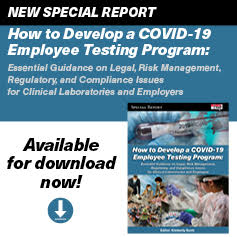HHS reporting guidelines may require some clinical laboratories to return CARES Act funds, but the good news is that clinical laboratories have a window to provide input
The Coronavirus Aid, Relief, and Economic Security (CARES) Act Provider Relief Fund (PRF) has provided an essential lifeline for healthcare companies and providers that were struggling to maintain financially viable operations in the context of the hardships created by the pandemic. Many clinical laboratories received these funds, helping to offset the losses experienced by declining test volumes.
According to a recent article by Bass, Berry and Sims, a Tennessee based national law firm with expertise in the area of healthcare payer-related legal issues, “The PRF, which reimburses eligible healthcare providers for healthcare-related expenses or lost revenues attributable to COVID-19, requires recipients to agree to comply with reporting requirements as a condition on the receipt of funding.”
While these funds have been a mainstay to many clinical laboratories during the pandemic, the initial details of reporting requirements for PRF payments have only just become available. These reporting requirements, recently released by the Department of Health and Human Services (HHS), may see clinical laboratories and other providers having to return some or all of their PRF payments.
To better understand the implications of these new reporting requirements, the COVID-19 STAT Intelligence Briefings Service spoke with Bass, Berry and Sims attorney Danielle Sloane. Sloane is an experienced healthcare regulatory attorney, who specializes in helping healthcare providers and suppliers navigate the complexities of federal and state health care regulations.
“The most significant implications of the new HHS reporting guidance is HHS’s new approach to one, prioritize COVID-attributable expenses, and two, change how providers are required to measure their lost revenues, including effectively limiting provider’s use of the PRF to only support lost revenues up to their 2019 profits,” Sloane said. “I’m getting more questions every day about it from a variety of different clients, each of whom are concerned about the implication of this.”
Sloane explained the inferred rationale behind these new requirements. “HHS is aiming to first and foremost cover expenses that support COVID-19 attributable expenses and help providers maintain capacity to serve the public health needs of the country. However, HHS caught wind of some companies reporting higher profits in the second quarter of 2020 as compared to last year,” Sloane explained. “It wasn’t necessarily because their revenues were higher, but it’s because they recognized PRFs received from HHS to cover their lost revenues in conjunction with realizing lower costs due to early cost-cutting measures (e.g., temporary pay cuts and furloughs).”
HHS Scrutinizing Profits of Those Who Took CARES Act Funds
 “These companies may have recognized the same amount of revenue as last year, but ultimately incurred fewer expenses,” Sloane said. “Fundamentally, HHS wants the funds to go to COVID-attributable expenses and to cover losses resulting from the pandemic, but does not want companies to profit because of HHS funds beyond what they otherwise would have profited, had coronavirus not come into play.”
“These companies may have recognized the same amount of revenue as last year, but ultimately incurred fewer expenses,” Sloane said. “Fundamentally, HHS wants the funds to go to COVID-attributable expenses and to cover losses resulting from the pandemic, but does not want companies to profit because of HHS funds beyond what they otherwise would have profited, had coronavirus not come into play.”

While Sloane believes the intentions behind this approach were understandable, requiring a comparison to 2019 instead of budgeted 2020 profits has created challenges for some providers. “The way the guidance is written, if you experienced a loss in 2019, you can receive PRF only to break even this year. While one company that I am aware of was projecting to make a decent profit in 2020 prior to COVID after restructuring their business last year, now they are in a situation where HHS has just said their 2020 budget is no longer an appropriate measure, effectively causing them to incur the negative impact of the 2019 one-time events that prevented them from being profitable last year a second time.”
CARES Act Reporting Clarifications Possible
These new reporting requirements could have a strong impact on providers’ ability to retain CARES Act funds for some clinical laboratories, but Sloane suggested that more clarifications could follow. “I suspect HHS may end up developing some reasonable mechanism for laboratories and other healthcare providers to articulate why their 2019 actual revenues are not sufficiently comparable and adjust them based on one-time non-COVID related events,” Sloane propounded, “such as new acquisitions, dispositions, changes in reimbursement, voluntary repayments, etc.”
Sloane also explained that for clinical laboratories that may be affected by these new requirements, now is the time to add their input to HHS.
“I think people really should be looking at these concepts now, because if it does affect them in a negative way, now is the best time for them to provide input,” Sloane advised. “Now is really the time to influence the user guide, the portal, and to get commentary in. I’m sure that CAP and American Clinical Laboratory Association are probably considering the guidance, but the more HHS hears from providers and understands it from them, the better.”
Two Proactive Steps for Clinical Laboratories to Avoid HHS Ding
Clinical laboratories, particularly those doing COVID-19 testing, may have sufficient expenses to support the PRFs they received. If, however, they need to support the funds with lost revenue, they should take the time to evaluate whether the changed calculation of lost revenues impacts their ability to support retention of the funds. Those that are affected should take the time to provide input to HHS or their industry association about impacts to their organizations, and proposed solutions regarding how the intentions of these reporting requirements can be fulfilled while taking into consideration the unique situations that some clinical laboratories have.
Another action Sloane suggests for clinical laboratories to consider is to reevaluate any conservative cost-cutting measures taken as a result of COVID-19. Sloane provided examples of clinical sites that are now making workers whole for any salary cuts or furloughs, or providing hazard pay for employs serving on the front lines.
Ultimately, clinical laboratories should keep apprised of developments of the reporting requirements related to CARES Act funding that they have received. These labs should ensure that they not only meet the requirements but submit timely, accurate reports—the first report will be due Feb. 15, 2021. Laboratory leaders should provide input to HHS regarding these reporting requirements now, when their recommendations and feedback are likely to have the greatest impact.

—By Caleb Williams, Editor, COVID-19 STAT
Related Resources:
HHS: Post-Payment Notice of Reporting Requirements
Bass, Berry and Sims: HRSA Releases Details on Provider Relief Fund Reporting Requirements







